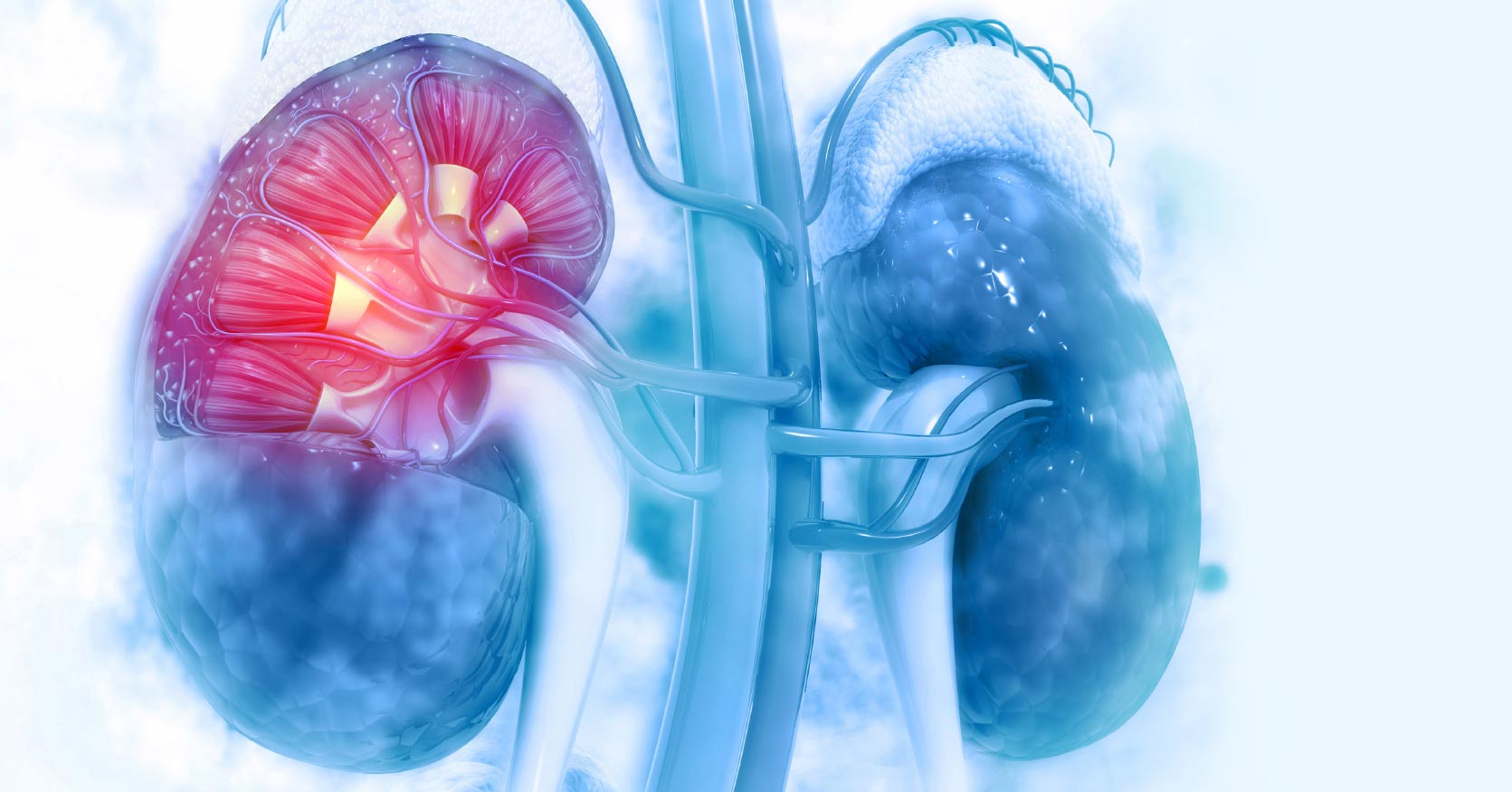Diabetic Kidney Disease
High blood glucose damages blood vessels in the kidneys
Diabetic nephropathy (diabetic kidney disease) is one of the complications of type 1 and type 2 diabetes. Although there is no way to prevent diabetes complications, modern treatments take into consideration keeping kidneys healthy and maintaining and controlling diabetes levels at the same time to reduce complications or at least delay their onset.
The main function of the kidneys is to filter waste products and excess water from the bloodstream so that they can be excreted in the form of urine. Kidneys are also involved in controlling blood pressure and secreting hormones. Kidney damage means that blood cannot be filtered properly which may lead to waste accumulation in the body.
High blood glucose damages blood vessels in the kidneys. This damage lets protein into the urine leading to high blood pressure that damages the kidneys. Although both types of diabetes lead to kidney damage and other health problems, type 1 is more likely to cause the damage.
Diabetes is the number one cause of chronic kidney disease (CKD). According to the latest international medical studies, more than 50% of the cases of CKD are caused by diabetes.
High blood glucose and urine glucose levels in diabetics, especially those who are not following a diet and treatment plan, affect the filtration units of the kidney. Over the years, this leads to kidney damage where the patient does not feel any symptoms.
The disease does not appear until the later stages, i.e. after years of having diabetes, which leads to difficulty in maintaining kidney function and consequently having CKD. Regular follow-ups with the doctor appear to be very important for diabetics. Normally, kidney damage caused by diabetes progresses slowly and may take several years before showing symptoms. Symptoms of diabetic nephropathy may appear 15-20 years after a diagnosis of type 1 diabetes. Hence, it is fundamental for diabetics to start following the necessary protection measures to reduce the damage.
Diabetes starts affecting kidneys by limiting their function and reducing their ability to remove urea from the blood.
At later stages, it leads to a complete failure in the filtering systems of the kidneys. There is no treatment for diabetic nephropathy or for glomerulosclerosis associated with the disease.
However, there are procedures that contribute to reducing the aggravation of the disease and delaying kidney failure such as regular treatment for diabetics, high blood pressure reducers, maintaining a healthy diet, and abstaining from smoking.
It is difficult to predict which diabetic patients will develop diabetic nephropathy, but there are some dangerous factors that lead to its development which are the lack of control of blood glucose levels, type 1 diabetes that started before the age of 20, high blood pressure, and a family history of diabetes and CKD.
Diabetic nephropathy patients usually have the following symptoms:
- Worsening blood pressure control
- Increased need to urinate
- Protein in the urine
- Swollen feet, ankles, or hands
- Reduced need for insulin
- Difficulty concentrating and confusion
- Loss of appetite
- Nausea and vomiting
- Persistent itching
- Fatigue
Diabetic nephropathy has 5 stages:
Stage 1
More blood passes through the kidneys leading to increased filtering and kidney enlargement without the patient feeling any symptom. This stage may last for years.
Stage 2
Glucose begins affecting the filtration units of the kidneys. Small quantities of albumin (protein) are found in the urine without any symptoms. At this stage, diabetics are able to preserve their kidneys and not reach stage 3, especially if they maintain their blood pressure and blood sugar levels.
Stage 3
The patient loses large amounts of albumin in the urine as a result of the damage of the filtration units that lose their ability to prevent blood proteins from leaking into the urine and thus losing them. Kidneys also lose their filtering ability leading to high levels of waste in the blood. This stage can be easily detected upon a urine routine test in addition to high blood pressure. It lasts for many years leading to gradual kidney function deterioration if the patient is not treated.
Stage 4
Stage 4 is overt diabetic nephropathy, whereas the filtration units lose about 75% of their ability to filter blood. Most patients at this stage suffer from high blood pressure and deterioration of other kidney functions.
Stage 5
A person with stage 5 CKD has end-stage renal disease (ESRD) in which the kidneys have lost their filtering ability leading to the complete appearance of symptoms. At this stage, patients often suffer from general weakness, loss of appetite, insomnia, anemia, lack of urination, and fluid accumulation in the legs and abdomen and sometimes in the lungs and heart leading to breathing difficulties. Patients who do not undergo dialysis (hemodialysis) or kidney transplant may enter coma and ultimately die.
Microalbuminuria Test
The first sign of diabetic nephropathy is albuminuria. Urine samples provide the doctor with the necessary information on kidney function or the presence of a large amount of albumin in the urine. Albuminuria results from damage within the kidneys. People with type 2 diabetes should be tested for microalbuminuria at diagnosis. On the other hand, patients with type 1 diabetes should be tested for microalbuminuria annually five years after diagnosis. Collecting the first urine voided in the morning for examination is preferred to avoid the error caused by the difference in the amount of albumin. Urine should be collected and checked again within 3-6 months for the final diagnosis. If it contains albumin, kidney function and cholesterol tests must be performed. The test is repeated once every year if the result is normal. It is a simple and inexpensive test. The analysis can be done by taking one urine sample and measuring the percentage of albumin in it or by collecting urine specimens for a period of 24 hours and measuring the percentage of protein in them in general.
Microalbuminuria is an early sign of diabetic nephropathy. Studies have shown that microalbuminuria in diabetics is also associated with possible cardiovascular effects.
So, the early sign of diabetic nephropathy is a tiny but abnormal amount of albumin in the urine (<30 mg/24 h). In this case, if there is no rapid medical intervention, 80% of diabetics will have an increased level of urinary albumin and reach the stage of diabetic nephropathy. The amount of urinary albumin increases then to more than 300 mg/24 h leading to ESRD. Medical research has shown that patients with type 2 diabetes are two to three times more likely to develop cardiovascular disease if they have a tiny amount of urinary albumin. If that amount increases, the chance of developing cardiovascular disease increases to tenfold. This is the same chance patients with type 1 diabetes have.
Methods of Treatment
Albuminuria requires rapid intervention in order to prevent the condition from developing and reaching ESRD. Albuminuria in diabetic patients indicates that there are changes in blood vessels and correlates with high blood pressure.
Doctors prescribe some oral medications to treat high blood pressure. When blood pressure in these vessels decreases, kidney damage also decreases and thus the amount of proteins that leak from blood into urine is greatly reduced.
The important step of the treatment is to reduce the intake of salt and animal proteins such as meat and other to 0.6 g/kg per day. This requires the patient to adopt a healthy diet specific to his condition and follow-up with a nutritionist.
Prevention is the best way to protect kidneys from diabetes. The most important step is to maintain a normal blood glucose level by adopting a diet, exercising, and taking medications regularly according to the recommendations of the treating physician.
Prevention is also accomplished by controlling blood glucose level and blood pressure. A fasting blood glucose level should range between 80-120 mg/dL and be less than 140 mg/dL after eating. A diabetic patient should not have a blood pressure of more than 130/85, or else it will accelerate the damage of the kidneys.
Recent studies have proven that controlling the level of blood glucose for long periods reduces the risk of serious diabetes complications, the most important of which are nephropathy and retinopathy. Periodic follow-ups with the treating physician and routine tests are key to diagnosing the disease at an early stage and thus starting the treatment.
















